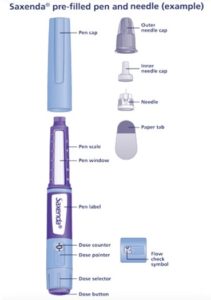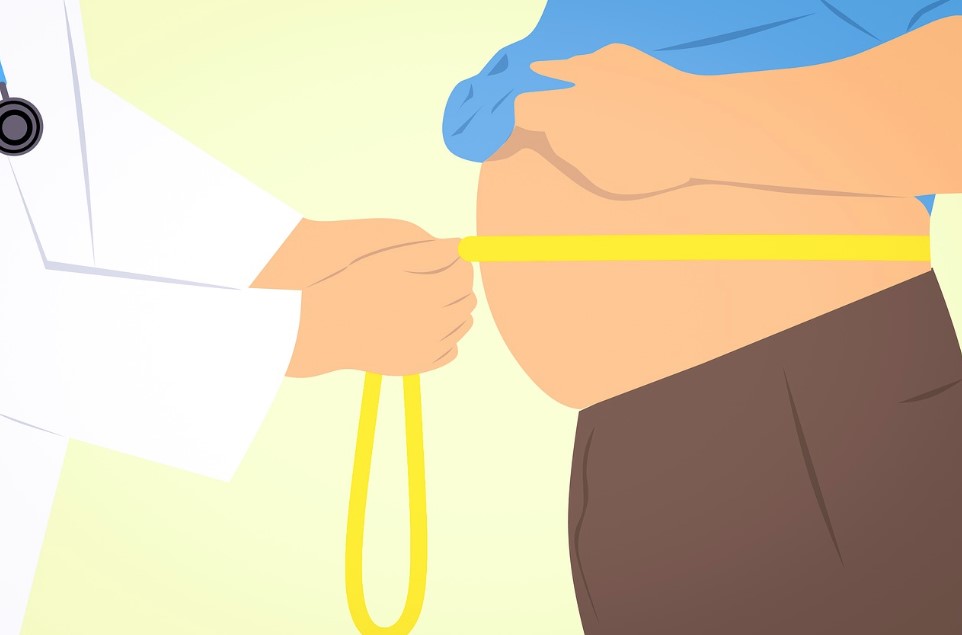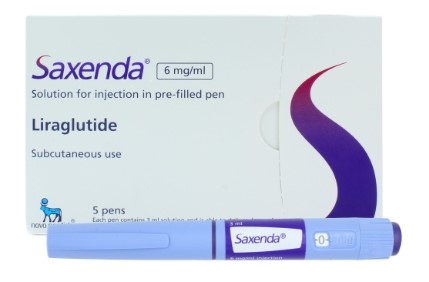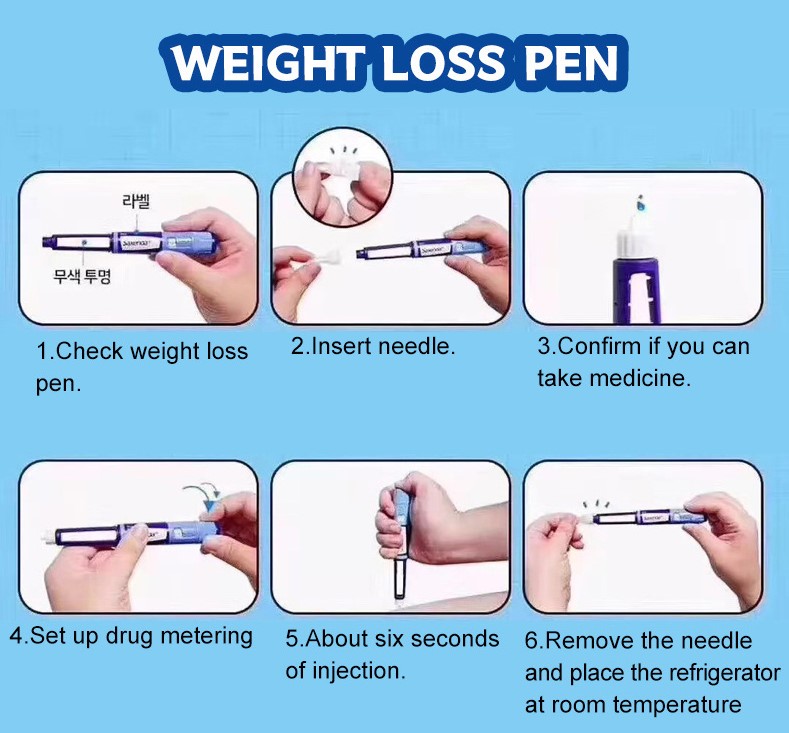Embarking on a weight loss journey can be challenging and overwhelming, but success is within reach with the right tools and guidance. Saxenda injections have emerged as an FDA-approved solution that offers promising results when combined with healthy lifestyle changes.
In this blog, we demystify Saxenda by breaking down its benefits, mechanics, proper usage techniques, dosage management tips, and overall integration into your daily routine for smooth sailing toward reaching your goals.
Key Takeaways
- Saxenda injections are a medically-proven daily injection designed to aid in weight loss, specifically for adults with a BMI of 30 kg/m² or higher or those with a BMI of 27 kg/m² and at least one weight-related comorbidity.
- Proper preparation, administration technique, dosage management, aftercare, and monitoring are all critical components of a successful Saxenda journey. Read more below on how to do this safely.
- The starting dose for Saxenda is 0.6 mg daily, which can be increased gradually up to 3 mg per day. Patients must keep their Saxenda pen private from others due to contamination risks and potential harm from an incorrect dose.
Also be sure to read a first-hand Saxenda review from one of our BDAWeightwise clients, Henry Williams.
Understanding Saxenda Injections
Saxenda injections are an FDA-approved weight loss treatment that regulates appetite and reduces calorie intake. In our view, it’s essential to understand how the medication works before using it as well as the potential side effects.
Definition And Benefits
Saxenda is an FDA-approved daily injection designed to aid in weight loss, specifically for adults with a Body Mass Index (BMI) of 30 kg/m² or higher or those with a BMI of 27 kg/m² and at least one weight-related comorbidity.
This medication must be taken in combination with healthy lifestyle changes, such as a reduced-calorie diet and increased physical activity, and has been proven to be beneficial for high-BMI individuals.
By adhering to the recommended dosing schedule and working closely with a healthcare provider, patients can expect significant improvements in their overall health resulting from decreased body weight.
How Saxenda Works And Potential Side Effects
Saxenda, or liraglutide, offers a unique approach to promoting weight loss by targeting the hormonal mechanisms that control hunger and satiety. The injection’s active ingredient is a glucagon-like peptide-1 (GLP-1) receptor agonist, miming the effects of naturally occurring GLP-1 in the body.
By stimulating the release of insulin and suppressing glucagon secretion, Saxenda helps regulate blood sugar levels while simultaneously reducing appetite and slowing gastric emptying.
Although Saxenda is generally well-tolerated among users, it has some potential side effects that one should be aware of before beginning treatment. Common side effects include nausea and diarrhea; however, most people find these symptoms subside as their bodies adjust to the medication over time.
Other possible adverse reactions may consist of abdominal pain or bloating caused by slowed gastric emptying – an effect that can lead to constipation in some cases – and increased heart rate due to its impact on certain hormone levels in the body.
While using Saxenda alongside proper diet and exercise routines can yield desirable results for many patients, being proactive about managing any related discomforts or risks is crucial when using Saxenda injections as part of a comprehensive lifestyle plan.
Steps For Proper Usage Of Saxenda Injections
Preparing for and correctly administering the Saxenda injection is crucial for effective weight loss.
 Preparing For An Injection
Preparing For An Injection
Before you begin using Saxenda, preparing for the injection process is essential to ensure a smooth experience. Start by washing your hands thoroughly with soap and water.
Then, remove the Saxenda pen from its storage and inspect it carefully to ensure it’s not damaged or expired.
Next, gather all necessary supplies, including an alcohol swab or cotton ball soaked in rubbing alcohol, a sharps disposal container for safe needle disposal, a new needle compatible with your Saxenda pen (usually supplied), and a clean surface on which to work.
Clean the rubber end of the pen with an alcohol swab before attaching a new needle securely by following the manufacturer’s instructions. Remember never to share needles or pens even if you change needles between users; this can lead to disastrous consequences such as infections or serious diseases like HIV/AIDS or hepatitis C transmission.
Administering The Injection With Proper Technique
Administering Saxenda injections properly is crucial to ensure a smooth weight loss journey. First, wash your hands before handling the pen and medication. Next, attach a new needle and remove the pen cap.
Before injecting, select an area of skin on your stomach, upper leg, or upper arm with appropriate subcutaneous tissue depth.
It’s essential to use each injection site only once and rotate injection sites with each dose to avoid skin irritation or hard lumps under the skin from too much medicine in one spot.
You can track which areas you have used by marking them on a body map included in the instructions for use booklet provided with your prescription. If you experience discomfort during administration, speak with your healthcare provider. They may suggest other techniques, such as using ice on the injection site before administering it or changing what time of day you take – discomfort should not be experienced long term.
Where To Inject Saxenda And How Often
To ensure proper absorption of Saxenda, it is important to inject it in the stomach area, upper leg, or upper arm as recommended by your healthcare provider.
The injection site should be rotated each time you administer a new dose and avoid injecting into a vein or muscle. According to the Saxenda dosing chart, the starting dosage for most patients is 0.6 mg per day for one week before increasing to 1.2 mg per day.
It’s preferable to inject around the same time of day daily; however, you can change the injection site and timing without adjusting your dose. It’s important not to miss any doses, but if this happens accidentally, take it as soon as possible within that day and continue with future injections at regular times unless otherwise instructed by your healthcare provider.
List Of Foods To Avoid While On Saxenda
To maximize the effects of Saxenda injections, it’s important to be mindful of your diet. Here is a list of foods to avoid while on Saxenda:
- Highly processed and packaged foods – These are often high in calories, preservatives, and additives that can hinder weight loss efforts.
- Sugary foods and drinks – Consuming too much sugar can lead to spikes in blood sugar levels, contributing to weight gain.
- Foods high in saturated fat – High amounts of saturated fat can harm heart health and lead to weight gain.
- Fried foods – Deep-fried or heavily battered foods are typically high in unhealthy fats and calories.
- Alcohol – Drinking alcohol can sabotage weight loss by adding unnecessary calories and interfering with hormone regulation.
Instead, focus on consuming healthy whole foods that are nutrient-dense and filling, such as lean proteins, fruits, vegetables, whole grains, nuts, and seeds. By making minor changes to your diet while taking Saxenda injections as your healthcare provider prescribes, you may see better results on your weight loss journey.
Storage of the Saxenda Injection Pens
Proper storage of Saxenda is essential to maintain its effectiveness and safety. Saxenda pens should be stored in a refrigerator between 36°F to 46°F (2°C to 8°C). It is important to protect the Saxenda pen from light by keeping it in the original carton until use. Do not freeze Saxenda or expose it to temperatures above 86°F (30°C). If necessary, Saxenda can be kept at room temperature (up to 77°F or 25°C) for a maximum of 30 days, away from direct heat and sunlight.
When traveling, Saxenda can be stored at room temperature in the original carton for up to 30 days. Avoid storing Saxenda in checked luggage or a vehicle’s glove compartment, as extreme temperatures can affect its potency.
Always check the expiration date on the Saxenda pen and do not use it if it has expired. Additionally, do not use Saxenda if the pen has been frozen or if it appears to be damaged or tampered with.
Using the Saxenda Weight Loss Pen
Using the Saxenda weight loss pen is a straightforward process. Here’s a short description of how to use it:
-
Prepare the Saxenda pen: Before using the pen for the first time, remove the pen cap and the sealing cap. Attach a new needle by twisting it securely onto the pen. Remove the outer needle cap, being careful not to touch the needle.
-
Set the dose: Turn the dose selector until the desired dose is displayed in the dose window. The dose can be adjusted in increments of 0.6 mg. The starting dose is usually 0.6 mg, and it is typically increased gradually over time as prescribed by your healthcare provider.
-
Prime the pen: To remove air bubbles and ensure the proper delivery of the medication, hold the pen with the needle pointing upwards. Tap the cartridge gently to make any air bubbles rise to the top, then press the dose button until the dose counter shows “0.” A drop of Saxenda should appear at the needle tip. If no drop appears, repeat the priming process until the drop is seen.
-
Administer the injection: Select an injection site on your stomach, upper leg, or upper arm. Clean the area with an alcohol swab and let it dry. Pinch the skin and insert the needle into the skinfold at a 90-degree angle. Press the dose button all the way in until the dose counter returns to “0.” Keep the needle in the skin for at least 6 seconds to ensure the full dose is delivered.
-
Dispose of the needle: After the injection, carefully remove the needle from your skin. Place the outer needle cap back on the needle and unscrew it from the pen. Dispose of the needle safely in a sharps container or as instructed by your healthcare provider or pharmacist.
Dosage Management
Adjusting Saxenda dosage is crucial for weight loss success. Patients typically start with a low dose, gradually increasing over four weeks until the total dose is reached.
Starting Dose And Dose Adjustment
As mentioned above, the starting dose for Saxenda® is 0.6 mg, injected once daily at any time of the day, with or without food. It’s important not to increase the dosage immediately as it can cause gastrointestinal side effects such as nausea, vomiting, and diarrhea.
The dosage can be increased by 0.6 mg each week until reaching the target dose of 3 mg daily if necessary.
It’s also essential to note that patients must never share their Saxenda® pen with anyone else due to contamination risks and potential harm from an incorrect dose.
Saxenda Dosing Chart
The Saxenda dosing chart provides clear instructions for patients on how to properly adjust their dosage over time, ensuring they receive the most effective and safe treatment for weight loss. Here is the chart:
| Week | Dosage (mg per day) |
|---|---|
| 1 | 0.6 |
| 2 | 1.2 |
| 3 | 1.8 |
| 4 | 2.4 |
| 5 | 3.0 |
| 6+ | 3.0 |
This chart is designed to help gradually increase the daily Saxenda dosage, starting at 0.6 mg per day during the first week and slowly increasing it by 0.6 mg each week until reaching the recommended 3.0 mg per day. It is essential to follow your healthcare provider’s instructions and consult with them before making any changes to the dosage.
Saxenda Missed Doses
If you miss a Saxenda injection, it is generally recommended to take the missed dose as soon as you remember, unless it is close to the time for your next scheduled dose.
If you miss a dose, it’s crucial not to double up on injections to make up for the missed one. Taking more than the prescribed dose can increase the risk of side effects without providing any additional benefits. It’s best to maintain a consistent dosing schedule as prescribed by your healthcare provider.
If you frequently miss doses or have difficulty adhering to the injection schedule, it is recommended to discuss this with your healthcare provider. They may be able to provide guidance or suggest alternative strategies to help you stay on track with your Saxenda treatment.

Aftercare And Monitoring
After each Saxenda injection, proper storage and disposal of needles and syringes are crucial for safety reasons. Patients should also monitor for potential side effects, such as nausea or diarrhea, and notify their healthcare provider if any issues arise.
It is important to have regular follow-up appointments with a healthcare provider to track progress and adjust dosages as needed.
Proper Storage And Disposal Of Needles And Syringes
After administering a Saxenda injection, it is important to store and dispose of the used needles and syringes properly. Needles should always be placed in a puncture-resistant container, such as a sharps disposal container, to prevent accidental needle sticks.
These containers can be obtained through healthcare providers or local pharmacies.
It is also crucial to ensure that used needles do not come into contact with other individuals or pets. Children and animals are especially vulnerable to accidental needle sticks, which can transmit infections or diseases like hepatitis B or HIV.
Monitoring For Side Effects And Following Up With Healthcare Providers
It is essential for patients using Saxenda injections to monitor for any potential side effects and follow up with their healthcare provider regularly. Patients should be aware of the symptoms of severe side effects, such as inflammation of the pancreas or gallbladder problems, and report them immediately to a medical professional.
In addition to monitoring for side effects, patients should schedule regular check-ins with their healthcare provider. During these appointments, providers can evaluate progress toward weight loss goals while keeping track of any medication adjustments needed to optimize results safely.
The initial follow-up appointment after starting Saxenda treatment should occur within 16 weeks when evaluating progress while maintaining safety standards in place by prescribing information guidelines.
Tips For Minimizing Discomfort Or Pain During Injection
If you are experiencing discomfort or pain during your Saxenda injections, there are steps you can take to make the process more comfortable. Here are some tips:
- Use a numbing cream: Applying a topical anesthetic cream on the injection site about an hour before injecting Saxenda can numb the skin and reduce discomfort during injection.
- Apply heat: Placing a warm compress on the injection site for a few minutes before administering Saxenda can help to increase blood flow and ease discomfort.
- Relaxation techniques: Deep breathing exercises or meditation can help to calm nerves and relax muscles, making the injection process less uncomfortable.
- Proper needle insertion technique: Make sure you insert the needle at a 90-degree angle in a quick, smooth motion. This will minimize discomfort during insertion and reduce the risk of bruising.
- Change injection sites: Switching up where you administer your Saxenda injections can help prevent soreness over time. Rotate between areas such as the upper arms, thighs, or abdomen.
- Speak with your healthcare provider: If pain or discomfort persists, speak to your healthcare provider about other treatment options. They may have additional tips or advice specific to your situation.
By following these tips, you can minimize discomfort and ensure your weight loss journey with Saxenda is as smooth and comfortable as possible. Always talk to your healthcare provider if you have any concerns about using this medication.

Conclusion And Final Thoughts: A Comprehensive Guide To Proper Usage And Instructions For Saxenda Injections
In conclusion, Saxenda injections can be a highly effective weight loss tool when used properly in conjunction with lifestyle changes. By following the step-by-step guide outlined in this article, patients can ensure that they use the medication safely and correctly.
Proper preparation, administration technique, dosage management, aftercare, and monitoring are all critical components of a successful Saxenda journey. Speaking with a healthcare provider for personalized guidance and support throughout the process is highly recommended.
FAQs:
- What is Saxenda injection, and how does it work for weight loss?
Saxenda is an injectable medication that contains liraglutide, a synthetic derivative of the natural hormone GLP-1. It reduces appetite and makes you feel fuller faster, which can lead to weight loss.
- Is Saxenda safe to use for weight loss?
When used as prescribed under the guidance of a healthcare professional, Saxenda is generally considered safe and effective for weight loss. However, like any medication, potential side effects and risks should be discussed with your doctor before starting treatment.
- How often do I need to take Saxenda injections?
The dosing schedule for Saxenda may vary depending on individual factors such as body weight and response to treatment. Most people start with a low dose that gradually increases until reaching the recommended maintenance dose of 3 mg daily.
- Can I still eat my favorite foods while taking the Saxenda injection?
While there are no specific dietary restrictions when using Saxenda, adopting healthy eating habits and regular exercise can help maximize weight loss results alongside medication use. Your healthcare provider can work with you to develop a customized plan that fits your needs and goals while using this drug safely and effectively.















